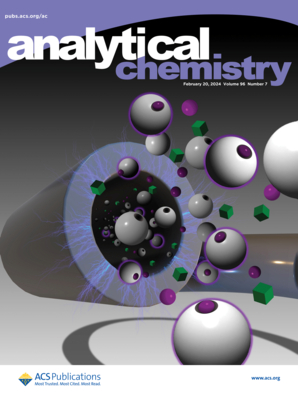吡咯修饰的二维氮化碳纳米颗粒实现超分辨率成像。
IF 6.7
1区 化学
Q1 CHEMISTRY, ANALYTICAL
引用次数: 0
摘要
石墨氮化碳(g-C3N4)作为一种优良的光电材料,在生物成像领域具有潜在的应用前景。然而,原始的g-C3N4尺寸过大,水溶性差,难以修饰,不适合直接用于生物成像。在此,我们提出了一种有效的修改方案。以吡咯为修饰剂,实现了g-C3N4的粒度细化和溶解度改善,增强了g-C3N4的荧光强度,并赋予其荧光闪烁性能。随后,通过纳米沉淀法将改性后的C3N4转化为水溶性荧光探针。最后,在特异性抗体的帮助下,我们使用该荧光探针实现了细胞微管结构的超分辨率成像,分辨率高达180 nm。该研究方法不仅克服了二维刚性材料应用于生物领域的困难,而且为其他二维材料在小尺寸可溶性荧光探针中的应用提供了新的途径。本文章由计算机程序翻译,如有差异,请以英文原文为准。
Pyrrole-Modified Two-Dimensional Carbon Nitride Nanoparticles Realize Super-Resolution Imaging.
Graphitic carbon nitride (g-C3N4), as an excellent optoelectronic material, has potential applications in bioimaging. However, the original g-C3N4 has an excessively large size and poor water solubility and is difficult to modify, making it unsuitable for direct use in bioimaging. Here, we propose an efficient modification scheme. By using pyrrole as the modifying reagent, we achieve size refinement and solubility improvement, enhance the fluorescence intensity of g-C3N4, and endow it with fluorescence scintillation properties. Subsequently, this modified C3N4 was transformed to water-soluble fluorescent probes through the nanoprecipitation method. Finally, with the help of specific antibodies, we achieved super-resolution imaging of cell microtubule structures using this fluorescent probe with a resolution of up to 180 nm. This research method not only overcomes the difficulties of applying two-dimensional rigid materials to biological applications but also provides a new approach of other two-dimensional materials in small sized and soluble fluorescent probes.
求助全文
通过发布文献求助,成功后即可免费获取论文全文。
去求助
来源期刊

Analytical Chemistry
化学-分析化学
CiteScore
12.10
自引率
12.20%
发文量
1949
审稿时长
1.4 months
期刊介绍:
Analytical Chemistry, a peer-reviewed research journal, focuses on disseminating new and original knowledge across all branches of analytical chemistry. Fundamental articles may explore general principles of chemical measurement science and need not directly address existing or potential analytical methodology. They can be entirely theoretical or report experimental results. Contributions may cover various phases of analytical operations, including sampling, bioanalysis, electrochemistry, mass spectrometry, microscale and nanoscale systems, environmental analysis, separations, spectroscopy, chemical reactions and selectivity, instrumentation, imaging, surface analysis, and data processing. Papers discussing known analytical methods should present a significant, original application of the method, a notable improvement, or results on an important analyte.
 求助内容:
求助内容: 应助结果提醒方式:
应助结果提醒方式:


